Carmelo Cruz Marcos Killing
The Cruz Marcos case is the last killing the Border Patrol Tucson Critical Incident Team covered up before being legalized within CBP.
The following is an analysis of investigation by the illegal and secret Tucson Sector Border Patrol Critical Incident Team (CIT) and the Cochise County Sheriff’s Office of the Border Patrol’s killing of Carmelo Cruz Marcos on February 20, 2022 near Douglas, Arizona. This is the last public use of force case the infamous and illegal Tucson CIT conducted under the Border Patrol before they were moved by former President Joe Biden to CBP’s Office of Professional Responsibility to further shield and hide their obstructions of justice from the press and public.
This analysis only addresses the work of the Tucson Sector CIT and the Cochise County Sheriff’s Office (CCSO) investigators who worked with them to obstruct justice and contaminate evidence so that the prosecution could not bring charges.
Please see my other posts in this newsletter to learn more about the CITs.
Carmelo Cruz Marcos was shot and killed by Border Patrol Agent Kendrick Staheli on February 19, 2022 in the Douglas, Arizona area. The Tucson Sector Border Patrol illegal CIT was allowed to act as the evidence collection team for the Sheriff’s investigators. It is important to remember that families and defense attorneys did not know these teams were illegal and had no authority to act as evidence collection teams or investigators. All agencies involved in this investigation knew that the CIT was ordered disbanded because they did not have the legal authority to act as an evidence collection team or investigators.
First came the CCSO bizarre Facebook press releases.
On February 20, 2022, they claimed they had been notified by Border Patrol about a person who was “seriously injured.” They then deleted that post and replaced it with this post admitting that the man had been shot by a Border Patrol agent.
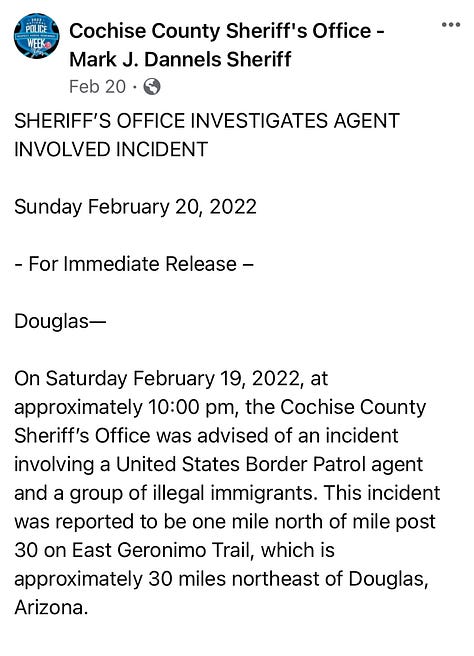
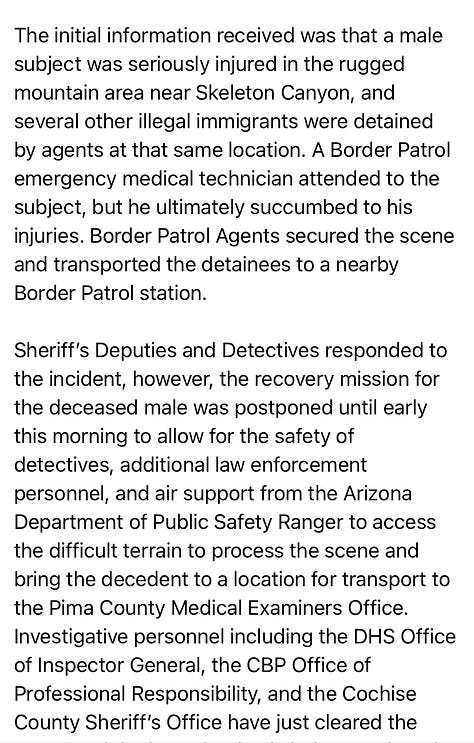
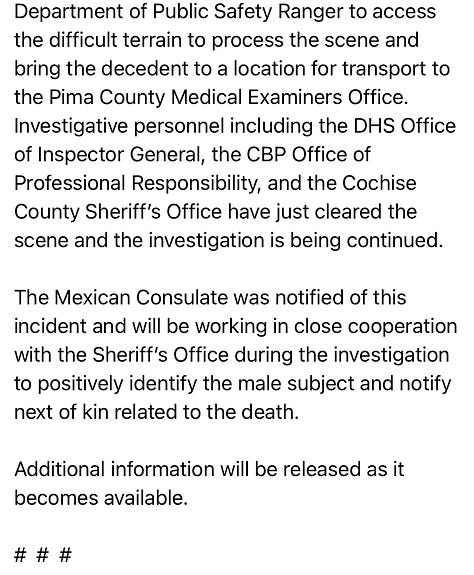
On February 24, 2022, CCSO stated that “both the agent and the subject” had tripped and fallen multiple times before he was apprehended. The shooter who was later identified as Border Patrol Agent Staheli claimed the man punched him and that he then tackled the him. The man was face down with the agent on top of him, and he refused to give him his hands. CCSO stated the agent claimed the man then hit him in the face with his elbow. (This is mater denied by the agent and found not to be true at all.) CCSO stated the man got up and ran six feet away before picking up a “large rock” and making a “throwing motion with the hand that held the rock.” They said the agent feared for his life and fired multiple times.
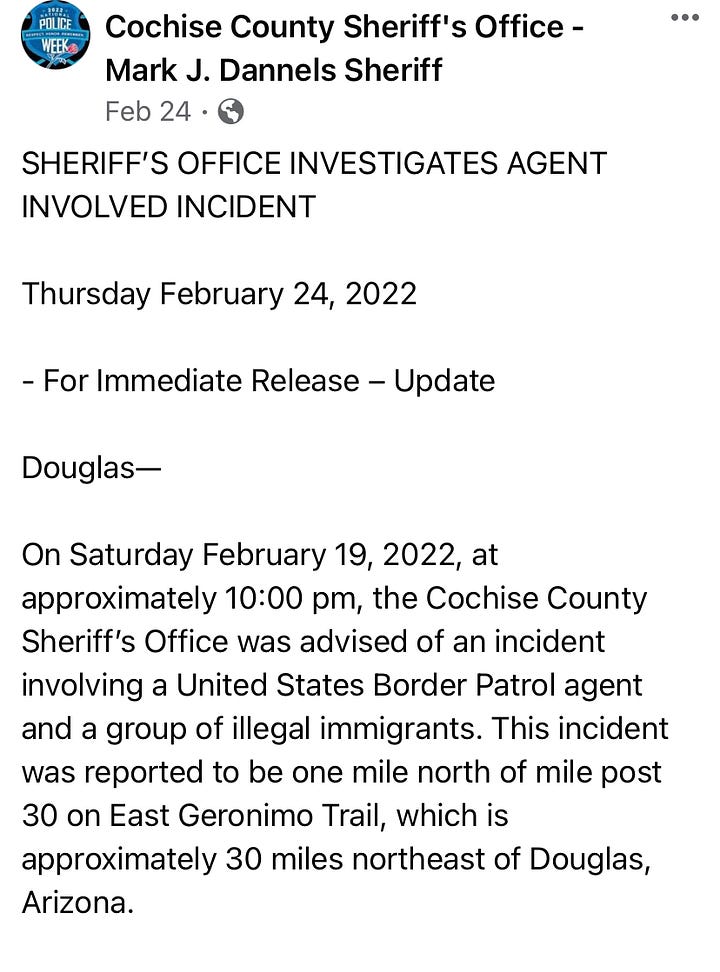
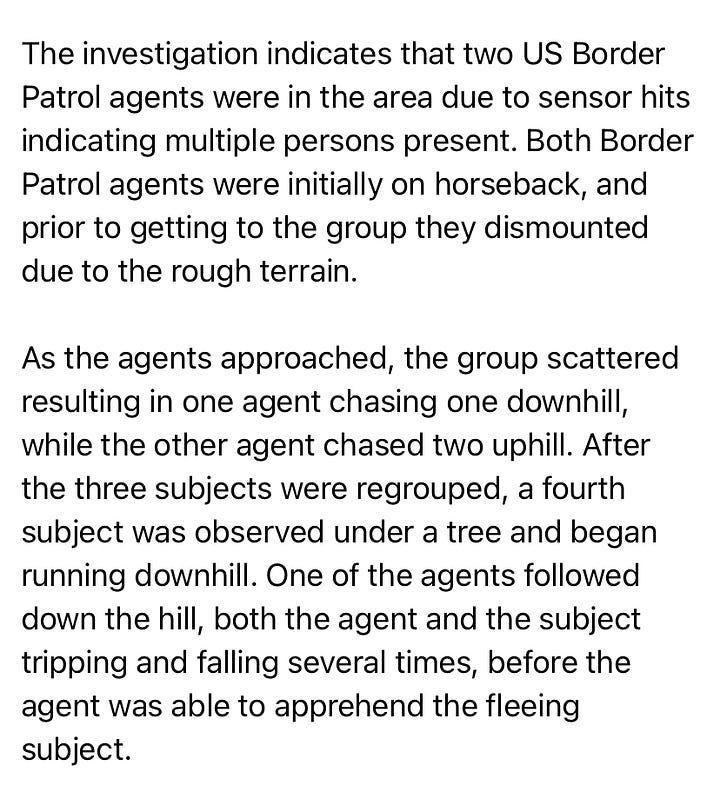
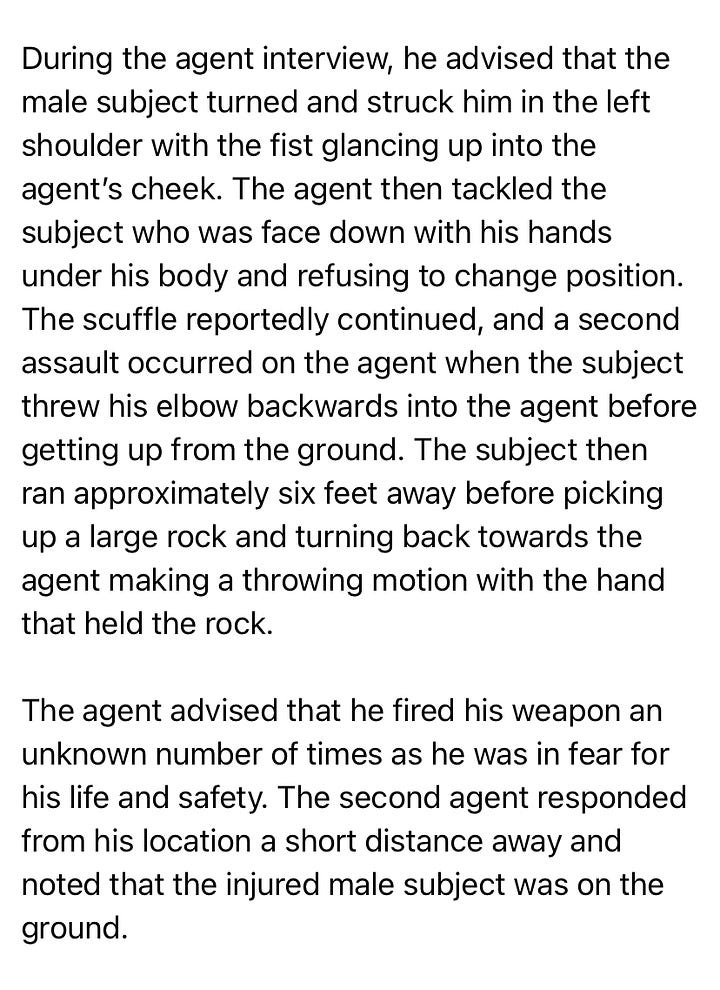
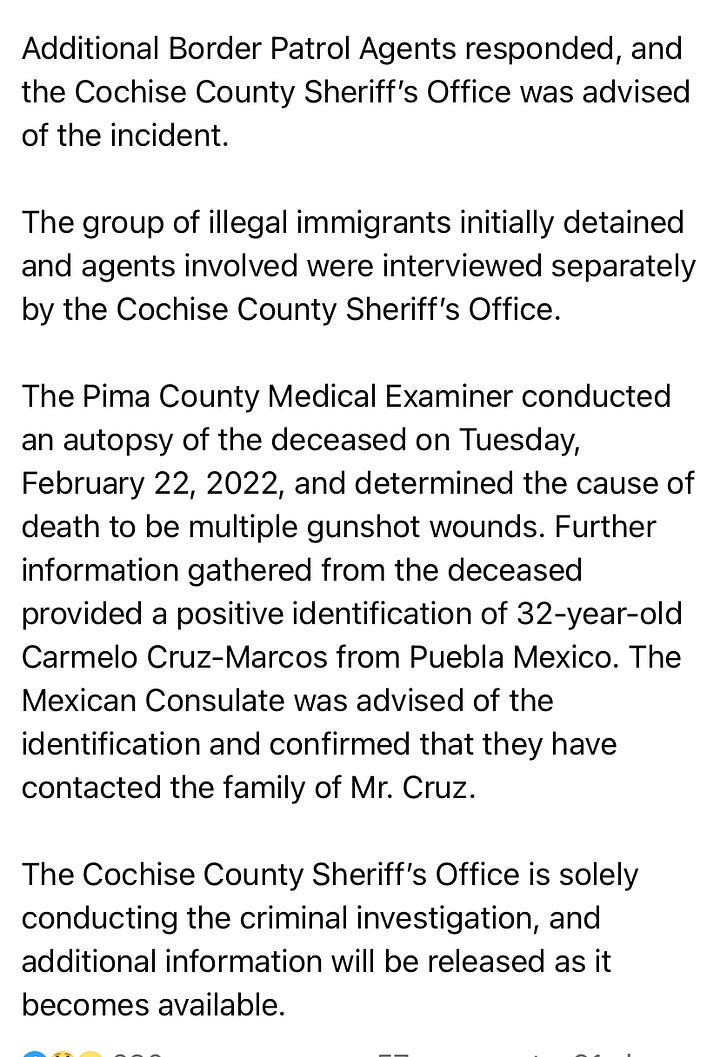
This feels weird to me as a former law enforcement agent. The specificity with which they are making the case to exonerate the shooter in a Facebook post just a few days after the incident screams unprofessional and as if they are trying to convince the public of this narrative. Investigators are not supposed to report out the investigation as it goes along. They are to do the investigation and then deliver a report of the facts and evidence to the prosecuting attorneys who then make judgements on whether it meets the elements of a use of force violation or not. Note how they did not mention any testimony from witnesses except the Border Patrol’s version of this incident. This is a common problem in these cases where investigators go out of their way to discredit testimony from migrants.
What I see here is CCSO jumping the gun on public bragging, screwing it up and then Border Patrol, CBP and CCSO working to get the narratives aligned. This is the first step in these coverups: controlling that narrative.
The man was identified publicly on the 24th as 32-year-old Carmelo Cruz Marcos.
Next, it is important to understand how this narrative was created. All of the following information can be found in the Cochise County Sheriff’s Office (CCSO) Incident Report #22-03910.
CCSO was notified of the killing of Cruz Marcos at 9:45pm on February 19, 2022. Officer B. Lomeli documented a call from SEACOM Officer A. Bryan that a male subject with a gunshot wound to his neck and chest had been found by Border Patrol. Lomeli stated he then called Border Patrol to clarify, and they stated it was an officer involved shooting in the Skeleton Canyon area. (page 2) This level of confusion is not unusual in the first reporting of a shooting. I do not find this inconsistency abnormal or nefarious.
He stated the unnamed Border Patrol agent told him that agents had been tracking a group and an agent shot an undocumented migrant, but that he did not know what led up to the shooting. (page 2) Lomeli advised Corporal Davidson who ordered him to contact CCSO Detective J.C. Hoke who was the on-call detective at the time. (page 3) Lomeli met Detectives Hoke and Detective Spezzano at the Douglas Border Patrol station and was told he was no longer needed. (page 3)
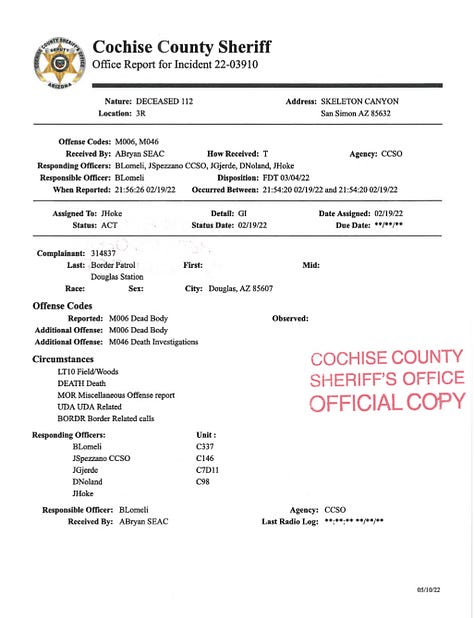
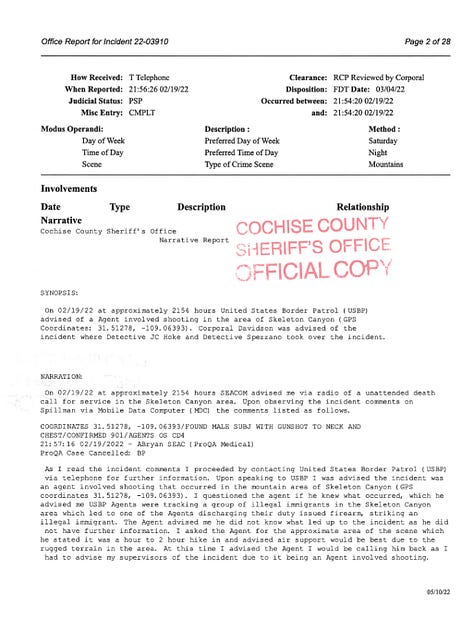

CCSO Detective J.C. Hoke responded at approximately 10:15 pm. He then called Special Agent Heston of CBP-OPR (Office of Professional Responsibility) investigations that was then led by former Border Patrol Agent Daniel Altman and a team of mostly former Border Patrol agents. He then requested the illegal Border Patrol Tucson Sector CIT respond for evidence collection. He was told at this time that the agent who killed Cruz Marcos was Border Patrol Agent Kendrek Bybee Staheli. CBP-OPR Special Agent Heston confirmed that the FBI declined to investigate. (page 3)
CBP-OPR Special Agent Heston stated neither CBP nor Border Patrol would assist the CCSO detectives in getting to the scene, and that Border Patrol BORTAC (SWAT) had been sent to the scene and told how to secure it. This denial to assist the investigators who have the authority to investigate Border Patrol use of force incidents is key to their coverups. Agents are told to always notify CITs first so that they can get the evidence to align with the narrative. This is standard Border Patrol training and was originally listed in the secret Border Patrol Use of Force Handbook of 2010 and earlier editions. It is also what I was instructed to do as an Acting Supervisory Border Patrol Agent at Campo, Station in 2000 in the event of a use of force.
CCSO Detective Hoke then asked CBP-OPR Special Agent Heston if the illegal Border Patrol CIT could help him process the scene and was told he would have to contact CIT himself. This contradicts the previous statements by CBP that Border Patrol CITs work closely with CBP-OPR in processing scenes and that OPR is the lead. CCSO Detective Hoke called Border Patrol Agent Poligula and requested Border Patrol CIT be assigned to assist him and CCSO Sergeant Gjerde in processing the scene even though they knew Border Patrol CIT did not have this authority. Poligula replied that CIT was notified, but that they would not help detectives get to the scene via air transport. He then suggested Detective Hoke request air assist from CBP-OPR.
This constant refusal to help authorized investigators is done by Border Patrol management to allow the coverup CIT agents to control the scene. The CITs decide what is evidence and what is not. They tend to only collect the evidence that exonerates their colleagues and collect that evidence poorly so that it cannot be used in court.
CBP-OPR Special Agent Heston then called CCSO Detective Hoke back to see if Border Patrol CIT was responding. It appears there was little coordination between CBP-OPR and Border Patrol CIT as they were not even speaking to each other but speaking through CCSO Detective Hoke. However, CBP-OPR Special Agent Heston did report to Detective Hoke that Border Patrol Agent Staheli had a partner with him named Tristan Tang but that he did not see the shooting. (page 4) CBP-OPR Special Agent Heston was also aware at this time that agents Staheli and Tang had been removed from the scene and were taken closer to a road together in the same vehicle. Detective Hoke requested both agents be taken to the Douglas Border Patrol station. Sgt. Gjerde advised that CCSO could not get a helicopter to the scene until the morning. (Page 5)
This left the scene in the illegal Border Patrol CIT’s hands until the following morning.
Detective Hoke arrived at the Douglas Border Patrol station and was advised by Supervisory Border Patrol Agent Omar Rascon that the agents were still about 90 minutes away. While waiting, he met with DHS-OIG (Office of Inspector General) Agents Chrystal Diaz and Roberto Saenz at the station. (Page 5)
This means law enforcement investigators from the local to the federal level were involved in this investigation: Cochise County Sheriff’s Detectives, Border Patrol Critical Incident Team, CBP-OPR and DHS-OIG which often has ex Border Patrol agents as their investigators for Border Patrol use of force investigations as well. They claim this makes them “better” investigators, but it often creates a clown show of an investigation as you will see. Eventually, in the courtroom, an investigation like this becomes confusing for juries because the Union attorneys work with the Union agents who know what the evidence is and all the ways that it is compromised. And this does not even touch on the fact that Cochise County has a sheriff who has taken millions of dollars in DHS and CBP grants. His agency is supported heavily financially by these agencies his investigators are now investigating.
When the Border Patrol Union steward Border Patrol Agent Keith Bocharski arrived at the Douglas station, he would not let detectives interview Agent Staheli. (page 5) This is a tactic used by the Border Patrol to give them time to create their narrative. It is not required by law. Border Patrol simply demands it. Why 72 hours? Because in 72 hours, they will know what the evidence is from the Border Patrol CIT. In 72 hours, his Union paid attorney will know what to advise the agent to say and not to say based off the Significant Incident and Use of Force reports written with knowledge of what the CIT is finding. The Union and the management in D.C. would then agree upon a plan to make sure the public knows everything they want them to know and nothing they don’t want them to know just as they did in the Anastasio Hernandez Rojas killing.
Border Patrol Agents Staheli and Tang arrived at Douglas station together in the same vehicle, but the time is not recorded on the report. Union representative Border Patrol Agent Bocharski stated that Agent Staheli reported an injury to his hand and that he would take him to an urgent care facility. It was later determined to be a small bruise. (page 5) This is another important part to the narrative: the dead guy isn’t the victim. The agents are. In order for the Border Patrol agent to justify his use of force, he must claim his or another’s life was threatened. In this case, he had to say his life was threatened in order to justify him killing Cruz Marcos.
Border Patrol agents who kill on duty often claim injuries and quite often are found to have none. In the killing of Jose Antonio Elena Rodriguez, Tucson Sector Border Patrol could not claim the shooting agent was injured because the victim was in Mexico. So, the Union flew him to Las Vegas, Nevada claiming he was receiving threats even though no one knew who the agent was. These are all attempts to get investigators away from the agent in order to get their narrative straight. Attempts that non law enforcement persons are not afforded.
On February 20, 2022 at 3:35 am, CCSO Detective Hoke interviewed Agent Tang with CCSO Detective Spezzano. No mention is made in the written report if Border Patrol CIT was present, but my research shows they usually are for agent interviews. According to Tang, it took a couple of hours before BORTAC, BORSTAR and Supervisory Border Patrol Agent Stanley arrived on scene. (page 7) Agents Tang, Staheli and the migrants moved “down” to Supervisory Stanley’s position and waited while BORTAC and others found two more migrants from the group. This brought the total to one killed, five apprehended and four got away. (page 8) It also meant BORTAC agents were climbing and hiking around the scene and possibly damaged or lost evidence before investigators arrived. This is another tactic used by Border Patrol to destroy the scene. See the Elena Rodriguez link above.
CCSO Detectives Hoke and Spezzano met with Border Patrol CIT agents Stephen Feagley, Andrew Dickison and Supervisory Border Patrol Agent James Kondrat as well as Agent Staheli and his Union attorney Jim Calle to collect his gear as evidence. CIT collected all the evidence. (page 8)
That afternoon at 4:30 pm, CCSO Detective Hoke met again with DHS-OIG agents Diaz and Saenz and CBP-OPR agent Brian Irving to interview witnesses. The report does not state if CIT agents were present or not. (page 8)
Filomeno Ruiz Martinez (pages 8-9) stated that he did not see or hear anything. He crossed with Irving Torres Peralta and six others, but they were apprehended by an agent who spoke in English and told them to raise their hands. Detective Hoke noted here in his report that Filomeno claimed to not understand English but somehow understood he was being told to raise his hands. In my experience with migrants, it is likely he saw others raise their hands and that is how he understood, but Hoke insinuated that Filomeno understood more than he was letting on.
Irving Torres Peralta (page 9) stated he crossed with seven others. When the agents apprehended them, he said Agent Staheli said in English, “This is America motherfucker!” He told investigators that he “more or less” understood English. CCSO Detective Hoke wrote in the report that Filomeno and Irving were hiding together and that Filomeno stated he heard nothing. Hoke claims these statements contradict one another; Irving heard three shots but that his brother, Carlos Torres Peralta, told him there had been four shots. Detective Hoke assumed in the report that the migrant witnesses were talking with each other about what they had seen and heard. Irving stated he was “300 feet” from the shooting.
Witness confusion about how many shots are fired is not unusual.
CCSO Detective Hoke wrote that Juan Torres Peralta (pages 9-11) said he crossed with seven or eight others. He said as Agents Stahel and Tang were chasing them, one agent yelled out, “This is America!” and “Stop or I’m going to shoot you,” to Carmelo who ran off. Carlos stated he tripped on a rock and Agent Staheli caught him and said, “This is America motherfucker!” He did not see the shooting but believed the two agents moved Carmelo’s body. Hoke wrote that this was “confusing” and questioned how this conclusion could be drawn if Carlos did not see them moving the body. Yet Detective Hoke did not ask Carlos this question or to clarify. He only wrote his suspicions in the report.
Carlos stated he then heard Agent Staheli say, “motherfucker” after the shooting, and that he heard Agent Tang tell junior Agent Staheli not to speak to anyone about the shooting. Detective Hoke reported that Carlos said he heard Tang tell Staheli, “Don’t worry man. Don’t talk with no one and it will be fine.” Carlos stated to OIG agent Diaz that originally there had been more people in the group but that the guide got mad and left them. Detective Hoke opined that this means Carlos was confused about the incident. Carlos said he saw the flashes from the gun as Agent Staheli fired.
Horaldo Jiminez Cruz (page 11) said he crossed with nine other people, and that he was apprehended with Carlos. He thought he heard four to six shots. Again, he said he was about “300 feet” away from the shooting when it happened. He was handcuffed with Carlos and sat at Agent Tang’s feet when the killing occurred. He could not see or hear them talking.
Ricardo Huerta Nepomuceno (pages 11-12) was apprehended with Carlos as well, but he did not see anything. He stated that he heard three to four shots. He couldn’t understand English well but heard the agents saying the man was shot in the neck. He commented that all the witnesses were transported together in a van.
February, 22, 2022, Detective Hoke was called by CBP-OPR Special Agent Juan Chiriguayo and told he would re-interview the migrant witnesses. (page 12) Hoke then received a summary of those interviews on the 23rd. This is a trick used to find discrepancies in their testimonies. This then will cause doubts in the prosecutors about filing charges. It must be remembered that during this time, the witnesses are being held like criminals by the people who did the killing. It also scares the witnesses because they are being asked the same questions over and over by so many different people. It has the effect of contaminating their testimonies. The following is from his evaluation of these interviews. Hoke only comments on Carlos’ testimony as this is the only one that accuses agents of a murder.
On the re-interview of Carlos Juan Torres Peralta, Detective Hoke wrote that Carlos added testimony that he did not give when Hoke first interviewed him. This appears to have offended Detective Hoke who then comes to the conclusion that Carlos’ testimony to him must have been false. He based this decision on Carlos not mentioning he had a girlfriend and children living in the US.
Carlos stated to CBP-OPR Agent Chiriguayo that Agent Staheli told him: “Shut up or I will shoot you.” Detective Hoke again noted he never said this in his first interview with Carlos. Hoke believed this was further evidence of lying. He added in the report that he believed Carlos intentionally hid from him that he understood English well.
Carlos stated to Chiriguayo that the agents moved the body and that he heard them discussing how they should not talk to anyone about the shooting. He stated Agent Tang said to Agent Staheli: “It would all be okay and that he had his back.” Carlos said he then heard Agent Tang tell Staheli (who is junior to Tang) to just claim the decedent tried to throw a rock at him. Hoke notes these statements were made 2 days after the killing and suggested that Carlos was lying and that the witnesses had been talking even though he had no evidence. Detective Hoke concluded their statements must be false.
At no point did Detective Hoke take into account that witnesses could have been traumatized by the killing of fellow migrant and that they were being interviewed in the Douglas Border Patrol Station by the agents who just shot and killed a fellow crosser. Hoke never comes to the same conclusion in regard to Agents Tang and Staheli having two hours alone before anyone arrived at the scene, then hours together getting to the station after the incident. Staheli himself refused to provide a statement until after 72 hours later. The assumption was that agents told the truth and migrants lied even though the evidence stated otherwise.
On February 22, 2022, CCSO Sergeant Gjerde attended the autopsy. Detective Hoke failed to mention in his report that Border Patrol CIT agents were present. (pages 12-13) According to the Pima County Medical Examiner’s report, CIT agents attending were: Dickison, Foreman, Bajgrowicz and Gonzalea. The body was identified through fingerprints as Carmelo Cruz Marcos. CITs attend autopsies instead of waiting for the medical examiner’s report to get a jump on any dirt. Was there any alcohol or drugs in his body? If so, CITs leak that information to the Union and public information officers who then hit the press hard.
Remember, they are creating the narrative that the agent is the victim and the dead guy is the aggressor.
CCSO Detective J. Spezzano was present when Detective Hoke interviewed Border Patrol Agent Tang. According to Spezzano’s report, Tang stated that he heard Agent Staheli say multiple times for Carmelo to show him his hands. He said Carmelo made statements but that he could not understand him. This is odd because he can hear Agent Staheli giving lawful orders, yet cannot hear the man in front of Staheli. Agent Tang said that Agent Staheli was about “100 yards” from him and the three migrants he arrested. (page 15)
Note that the prior statements from the two witnesses above said they were about “300 feet” from Staheli. 300 feet is exactly 100 yards. This is unusual in that three different witnesses have the exact same distance in their statements. Also, it is unusual that the two witnesses from Mexico were quoted here by the various CCSO detectives as using the imperial standard of measurement that is used in the US.
What I am suggesting here is that the migrants did not say “feet,” and perhaps this measurement is not correct. It is likely there is some coordinating of testimonies by the investigators because we only get a synopsis of the interview and not an actual transcript of what the witnesses said. It could also be because these investigators often use the CIT agents to act as translators. We just don’t know in this case because they did not document it.
After Agent Tang heard multiple shots, he called out to see if Staheli was okay. Detectives did not question him as to how many shots he heard like they did with the migrant witnesses. Tang stated that Staheli responded: “Yeah, I’m fine.” Yet, he then claimed Agent Staheli was distraught and shaken up emotionally from taking Cruz Marcos’ life. Tang then ordered Agent Staheli to bring the three migrants down to near the body but not to where they could see it. Staheli did as ordered. Next he ordered Agent Staheli to collect their horses and bring them closer. This is immediately after Staheli just killed Cruz Marcos. After he just professed Agent Staheli was distraught and emotional, yet Tang had no problem ordering him around. Agent Staheli complied. (page 15) They waited about two hours for backup to arrive. He said they did not talk about the shooting at all during this time. (page 15) This contradicts the testimony of the migrants.
CCSO Detective Spezzano was present when Border Patrol CIT collected evidence from Agent Staheli and then took that evidence to Douglas CCSO. (page 16)
The following is from CCSO Detective Hoke’s supplemental report documenting an interview with the shooter, Border Patrol Agent Staheli. This interview occurred on February 23, 2022, more than 72 hours after the killing. The report stated that CCSO Sergeant Gjerde and Border Patrol Union attorney Jim Calle were present. (page 17)
Detective Hoke opened the interview by telling Agent Staheli what his partner, Agent Tang testified to in his interview. (page 17) This is outside of normal interviewing techniques as it would influence Staheli’s statements. It allowed the shooter to adjust his statements and make sure they aligned with his partner’s narrative.
Agent Staheli stated that Carmelo punched him in the face. He said that the type of camouflage being worn by the group was different than any other kind he had ever seen migrants wear, and that this made him think they were drug traffickers working for the cartel. (page 20) This statement is part of the Border Patrol playbook. I have seen the exact same statement used in many other Tucson Sector use of force cases that had no narcotics involved as this one did not. The reason for this accusation is that according to the law, the shooter merely has to demonstrate that he feared for his life. That fear doesn’t have to be legitimate, and this perceived fear has been enough to exonerate all Border Patrol agents in shootings while in the line of duty for over 100 years. Establishing why he fears for his life is important for the narrative.
Staheli said the punch slid off his shoulder and hit him in the jaw. He then tackled Carmelo to the ground. Then they both fell to the ground, and Agent Staheli said that Carmelo was on his stomach and that he was on top of his back. He said Carmelo refused to give him his hands and that he feared Carmelo was trying to get a weapon. When he got Carmelo’s left arm out from underneath him, he claimed Carmelo “tried” to elbow him. Staheli stated he was getting tired and that he realized Carmelo was “larger than him and could overpower him if he didn’t get him into custody.” (page 20)
Carmelo was 5’3” tall and 159 pounds according to the autopsy report. (page 3) The report did not give Agent Staheli’s height or weight. Mr. Cruz Marcos was not armed.
Agent Staheli stated he then punched Carmelo several times in the side of his face. Carmelo tried to buck Agent Staheli off his back and succeeded and then tried to get away from the agent. (pages 20-21) Carmelo then picked up a rock from the left side of where he was standing. Staheli noted the rock was seven to ten inches long, oval in shape and larger than a softball. He claimed Carmelo was facing him when he pulled his arm back as if he was preparing to throw the rock. The report stated that “when the subject cocked his hand back, he (Staheli) believed he was going to throw it at him, he (Staheli) said he thought the subject was attempting to kill him.” (page 21)
The first comment Agent Staheli made to his partner Agent Tang was that he was “fine,” and then he asks if he saw the shooting. Agent Tang tells him that he did not. It is then that Agent Staheli told Tang that Carmelo had picked up a rock and tried to throw it at him. Staheli then waited with the three migrants in custody while Tang waited near the body for about 90 minutes until BORTAC and a Border Patrol agent EMT arrived. Staheli did not mention going to get the horses as Tang mentioned in his statement, and CCSO detectives did not point out this discrepancy. (page 21)
Detective Hoke told Agent Staheli that Agent Tang said he (Staheli) was “emotional” after the shooting. It is only after he is told this that Staheli then repeats exactly what Tang said about Staheli needing to be held and that he was distraught. (page 21) In a court room, this is called leading the witness.
Agent Staheli denied saying, “This is America motherfucker!” (page 21) He claimed one of the migrants in custody asked in English if he shot Carmelo. He told him that he did. This migrant would be Carlos as he is the only one in the group able to speak English fluently. When Carlos asked him why he shot, Staheli replied that Carmelo tried to kill him. Staheli then told CCSO Detectives Hoke and Sergeant Gjerde that in his experience as an agent, those who speak English well are usually smugglers of drugs or humans. (page 22) There is no evidence to support this statement, and this is common Border Patrol xenophobic rhetoric taught in the academies and in the field.
CCSO Detectives Hoke and Gjerde then took it upon themselves to tell the shooter that all the migrants, meaning the witnesses, were transported together in one van and that they therefore spoke about the shooting with each other to get their story straight, thus contaminating their statements. (page 22)
The following was gleaned from CCSO Sergeant Gjerde’s supplemental report. Sergeant Gjerde was contacted by Border Patrol CIT Team Leader K. Haller as he drove to the scene. No time was given for this. Haller advised that he and other CIT agents would meet him at the scene. (page 24) Arizona Department of Public Safety Air Ranger flew two CCSO detectives, Border Patrol CIT members K. Haller, J. Jenson and L. Lourenco and CBP-OPR Special Agent J. Gage near to the scene. They then hiked another 30 minutes to the body. No time was given for this event. Border Patrol CIT agents did all the evidence photography and 3D imaging of the scene. (page 24)
Supervisory Border Patrol Agent Stricklin documented people entering the scene. Sergeant Gjerde entered at 11:40am, 2/20/2022. Gjerde noted yellow crime scene tape around the area where the body was found. Carmelo was still lying on his back more than 12 hours after the shooting was reported. Dried blood could be seen on his face. His clothing had been cut away from his neck to his boots. There were four heart monitor leads on his body from what Gjerde stated was the Border Patrol EMT. After Border Patrol CIT photographed the scene, they began their search for bullet casings and other evidence. No time was given for the start of the search. Found north of the body were “blood spots” on a rock. “There was a piece of meat/bone or tooth located near the blood droplets.” No time was recorded or who found the evidence. (pages 24-25)
CBP-OPR Special Agent Gage found a shell casing and was marked as #8 at about 1:00 pm. Border Patrol CIT Leader Haller found a 2nd casing at 1:05 pm and it was labeled as #9. At 2:00 pm, the body was placed in a medical bag. Sergeant Gjerde stated he began collect Carmelo’s clothes and found a fired bullet in them with blood on it. It was photographed by Border Patrol CIT and marked as #10. Once all the evidence was marked and collected, the body was flown out of the area. No time was given for this. All persons flown in checked the scene one more time to not leave anything behind and were flown out as well. No time was given for when they left. (page 25)
On February 23rd, CCSO Sergeant Gjerde stated he was with Detective Hoke during the interview with Border Patrol Agent Staheli and his Union attorney Jim Calle. This interview was conducted at the Tucson OIG office. (pages 25-26) Gjerde was given copies of scene photos and 3D diagram from BPCIT at the autopsy on the 22nd. Sergeant Gjerde received the Border Patrol CIT report, but it was not attached to the CCSO report. (Page 26) It has never been public and remains secreted by Border Patrol CIT.
The following are the conclusions of CCSO Detective Hoke and the investigation using only the Border Patrol CIT evidence. (pages 27-28) Hoke wrote that he believed the statements of agents Tang and Staheli were consistent with each other. He claimed both agents told the migrants that they were federal agents and that they were under arrest. Hoke did not record if this was said in English or Spanish.
He concluded that three of the four migrants were “aggressive” and had to be “forcibly taken into custody.” Nowhere in the CCSO report did it state by the agents involved at the scene that the group was aggressive. A few ran but neither Tang nor Staheli claimed the others were aggressive. This conclusion was not based in evidence or testimony.
Detective Hoke then fabricated in this supplemental report that Carmelo “assaulted” Agent Staheli with a rock and that he “continued to assault him with a rock.” Even Agent Staheli stated Carmelo did not actually assault him with the rock but that he made a motion with his arm that he believed was an intention to do so. Agent Staheli was never hit with a rock. Hoke then used this lie to claim that the agent feared for his life and was forced to defend himself.
Hoke stated that the two brothers, Carlos and Irving, were the only ones who claimed that they heard Staheli say, “This is America motherfucker!” and “I will shoot you.” Detective Hoke failed to note that Carlos speaks English fluently and Irving understood some English, while the others did not.
CCSO Detective Hoke admitted that they did not identify or recover the rock that Agent Staheli claimed Carmelo picked up. Hoke noted that the photos taken by Border Patrol CIT showed many rocks in the area as if this should be enough evidence. This is the most common tactic used by agents and CIT; Border Patrol agents are trained to say they thought they would be killed by a rock simply because rocks are ubiquitous on the border.
There has never been a recorded incident of a Border Patrol agent being killed by a rock. Injured, yes.
Detective Hoke further stated that the trajectory of the shots in Carmelo’s body with where Staheli said he was standing matched the scene. Yet, there is no evidence given in this report as to where Border Patrol Agent Staheli was standing. Carmelo was shot four times, but Hoke only recovered three casings. There was no evidence recovered indicating where Staheli was standing for the other round fired.
Hoke’s stated conclusion was that Carmelo was the “aggressor” and that Border Patrol Agent Staheli was forced to defend himself. (page 28)
It is odd to see such a conclusion in an investigative report. Investigations are supposed to only contain evidence and facts. It is up to prosecutors to decide if there is enough evidence to bring charges. Prosecution was denied. Agent Staheli and Tang presumably continue to work as Border Patrol agents. Carmelo’s family continues to miss him.
Conclusion:
Border Patrol management and the illegal Critical Incident Teams once again obstructed the actual investigators by refusing to assist in getting them to the scene in a timely manner to identify and preserve evidence . The CCSO investigators did not even arrive on scene for more than 12 hours after the killing. Agents reportedly searched the brush for more migrants, trampling over evidence and likely led to one of the four shell casings never being found.
CIT agents did as they were trained and placed all witnesses in the same van. In cases that have gone to trial, Union attorneys always point out that this would contaminate their testimonies and it often results in hung juries. Yet, case after case touched by Border Patrol CITs and CBP-OPR routinely do this because they know it will be kicked out of court. Even though CCSO, Border Patrol, CBP-OPR and DHS-OIG were aware by this time that the CITs were being disbanded because they had zero legal authority to behave as forensic evidence teams, they still used them to improperly identify, gather and transport evidence.
All migrant witnesses’ testimonies were discounted as lies by the CCSO investigators. Reasons why investigators believed they were lying included: being able to speak English well, not being able to speak English well, some thought there were three shots while others thought there were four, failing to tell CCSO that they had family in the US, not knowing exactly how many people were in the group and being placed by CIT in one van together. Reasons why they believed the agents involved include: they road in one car together, they both had the same story after waiting at the site for a few hours and because they believed Agent Staheli was “assaulted” by the decedent even though there was no evidence and the agent himself denied being hit with a rock.
Resources:
“Federal agent fatally shoots immigrant near Douglas.” Kold News 13. February 20, 2022.
“U.S. border agent accused of fatally shooting man on rugged trail in Arizona.” Associated Press. February 21, 2022.
Celaya, Edward. “Man killed by US border agent in Cochise County mountain trail.” Arizona Daily Star. February 22, 2022.
Celaya, Edward. “Sheriff's office: Border Patrol agent says man he shot, killed was about to throw rock.” Arizona Daily Star. May 22, 2022.
Devereaux, Ryan. “THIS IS AMERICA MOTHERFUCKER”:WITNESSES DESCRIBE BORDER PATROL KILLING OF MEXICAN MIGRANT.” The Intercept. May 12, 2022.
Cochise County Sheriff’s Office Report #22-03910.
Pima County Medical Examiner Report #22-0784.
Border Patrol Tucson Sector Critical Incident Team Report #: unknown and never released.
CBP-OPR Report#: unknown and never released.
DHS-OIG Report#: unknown and never released.




Thank you for making readers aware of this tragedy, of the likely injustices, lies, evasion and guilt identified in your detailed account... I heartfully hope that good will come from your efforts. And more accountability.
The level of lies and injustice of which we are aware, which we witness, and which it is clear, infect the behaviors of even our 'leaders' in this country is sickening.
May the lives of those who suffer and who die unjustly be somehow honored and redeemed. My condolences to all you who carry direct knowledge of such brutality and injustice.
Please correct your post about Disappeared in America- it is disappearedinamerica.org thx